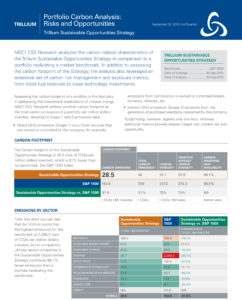Carbon Analysis: Risks and Opportunities in Trillium’s Sustainable Opportunities Strategy
DECEMBER 14, 2015: Trillium Asset Management recently engaged MSCI ESG Research to analyze the carbon-related characteristics of our Sustainable Opportunities Strategy, in comparison to a portfolio replicating a market benchmark.
 In addition to assessing the carbon footprint of the Strategy as of September 30, 2015, the MSCI analysis also leverages an extensive set of carbon risk management and exposure metrics, from fossil fuel reserves to clean technology investments.
In addition to assessing the carbon footprint of the Strategy as of September 30, 2015, the MSCI analysis also leverages an extensive set of carbon risk management and exposure metrics, from fossil fuel reserves to clean technology investments.
Assessing the carbon footprint of a portfolio is the first step in addressing the investment implications of climate change. MSCI ESG Research defines portfolio carbon footprint as the total carbon emissions of a portfolio per million dollars invested, drawing on scope 1 and 2 emissions data.
• Direct GHG (Green House Gas) emissions (Scope 1) occur from sources that are owned or controlled by the company, for example, emissions from combustion in owned or controlled boilers, furnaces, vehicles, etc.
• Indirect GHG emissions (Scope 2) accounts from the generation of purchased electricity consumed by the company.
Footprinting provides an important lens of carbon impact. The MSCI analysis, which can be found here, utilizes additional metrics, providing deeper insight into climate risk and opportunity in Trillium’s Sustainable Opportunities Strategy.







